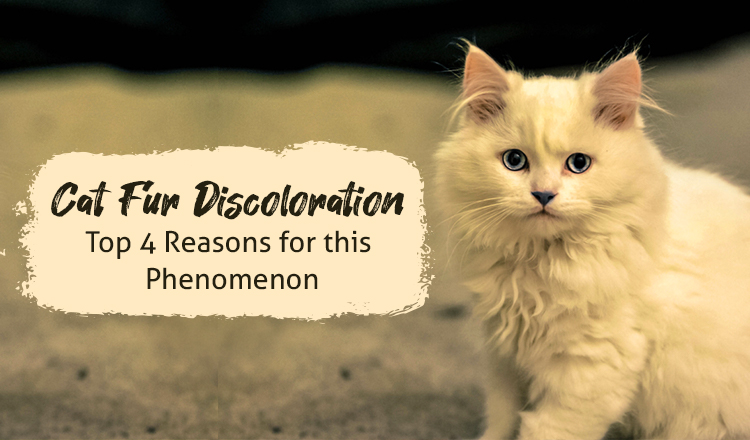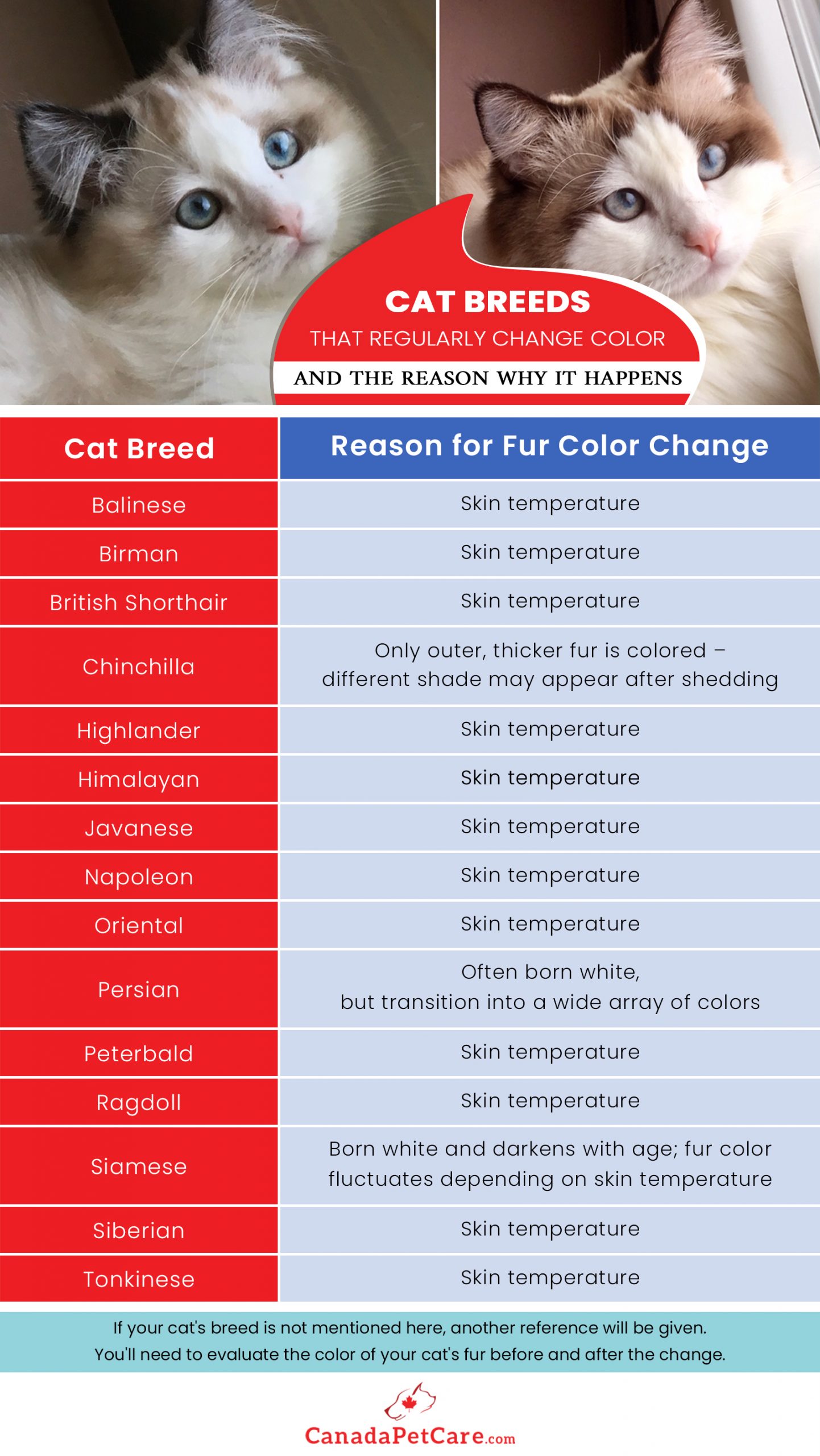When you first see your feline’s coat and find that your black colored kitty has a reddish brown color of his fur it is obvious to be panic-stricken. But believe us there is nothing to worry about. Just like human beings, your kitty undergoes several changes during her lifespan and this can take its toll on their fur too.
There can be quite a few reasons for the discoloration of your feline’s fur, but thankfully there is nothing to worry about as most of the prevalent causes are quite general.
Let Us Now Divert Our Attention to The Top Reasons for This Phenomenon to Occur:
1. Temperature in the Cat’s Environment
There are certain cat breeds like Siamese, Himalayan and other Oriental cats that have the color of their fur in accordance to the temperature of their skin. So we usually find that the cat’s feet, tail, ears and face are white or cream colored with darker points.
But skin temperature is not the only determinant in seeing the color of the fur. But the cat’s environment too can have an impact on the color of the fur. For example; Siamese cats get darker fur during the colder winter months.
2. Exposure to the Sun
As a human being, when you go out in the sunlight your skin gets darker and your hair gets lighter. Your feline is no different. If you have a cat that goes outside there are chances that she might expose herself to the direct sunlight that will have a tanned like effect on her.
This will lighten her fur. This is not a very big deal as a slight tanned fur will not affect the health of your kitty.
To protect your cats from the sun’s harmful rays and prevent skin problems caused by exposure to the sun, we recommend using the most popular product among pet parents SPF23 sunscreen.
3. Nutritional Deficiency
If the cat diet does not contain amino acid tyrosine it can lead your black cat’s fur change its color from black to reddish. Tyrosine is a mandatory requirement to produce melanin, a dark pigment in the cat’s fur and if the feline does not get adequate tyrosine than his ebony fur may become pale.
If the cat is facing other deficiencies like copper insufficiency or excessive zinc, then it can also transform black fur of your kitty to light. Before giving any cat supplements to your feline, it is important to consult with your veterinarian because the change in fur color can also be due to liver, kidney, or thyroid disease.
4. Age of the Cat
With age, cat’s fur starts getting gray just like human beings. But if your cat is not dark colored you may not notice the silver strands in it. The fur in Siamese cats and other dark-pointed Oriental breeds darkens with age.
When Siamese kittens are born they have white fur, but after getting out of the mother’s womb, they transform into different color which continues till their lifespan.
Changes in Fur Color and What They Mean
Take note of what color your cat’s fur should be in relation to the variation in hue. You will be able to find the correct explanation if you do so.
Cat’s Fur Turning Gray
Is your black cat beginning to turn white? It’s normal for your cat to turn grey as it gets older, particularly if it’s over the age of ten. This is due to the fact that a cat’s body contains less melanin as it ages.
The first grey hairs will grow around the muzzle. It’s possible that the grey fur could spread from there. Darker-colored cats have more grey hair than their lighter-colored counterparts.
There’s no reason to be concerned if your cat’s fur begins to grey over time. It’s all nature taking its course as long as it doesn’t happen overnight. In your mind, your cat may still be a kitten, but in feline years, it is a senior citizen.
Cat’s Black Fur Turning Brown
The first stage of greying is the fading of black fur to tan. A cat’s fur is unlikely to go from black to white in a single step. The phase of fading will be gradual and steady. If your cat seems to be too young to be greying, look for other signs.
If your cat is behaving strangely, it may be suffering from an organ problem. Take special care if you have chronic renal failure. This usually only affects senior cats, but it can occur in kittens as young as seven years old.
Examine how much time your cat is exposed to UV rays. If your cat avoids sunbathing and its fur turns black when the weather gets cooler, you have a perfectly reasonable explanation.
Cat’s Black Fur Turning Red
There are three possible reasons for black fur turning a rusty red color.
- Melanin development slows as cat get older.
- Cat fur has been bleached by the sun.
- Cat is deficient in the amino acid tyrosine.
There is nothing you can do if your cat is getting older. If the cat’s fur is being bleached by the sun, it could be exposed to too much UV light and be at risk of skin cancer. Dietary or supplementation should be used to treat a tyrosine deficiency. Excessive levels of this amino acid should be avoided.
Cat’s Brown Fur Turning Black
Excessive tyrosine causes brown fur to darken to black color. Make sure your cat gets enough of this amino acid. A cat’s health depends on finding the right combination of vitamins and minerals.
Excess protein in the diet can also contribute to this transition. Older cats require protein, according to Veterinary Clinics: Small Animal Practice. They, more than any other food category, need this. Only be careful not to overfeed protein-rich treats to an elderly cat.
Cat’s Light Fur Turning Brown
Adult cats that are lighter in color rarely become darker over time. This isn’t likely to be related to a food allergy. A cat with white or light brown fur would be unable to darken enough due to a lack of pigmentation.
When the temperature drops, the cat’s fur darkens whether he or she has pointed coloration. This is due to the fact that the skin darkens as well. Check your cat’s temperature. The cat is good if the temperature is between 100.5 and 102.5 degrees Fahrenheit.
Your cat’s fur may have become stained, particularly if it spends time outside. The feces from the litter tray could also stain your cat’s hair.
Bottom Line
Chances are that the color change that you are seeing on the cat’s fur is due to excessive sunbath or nutritional deficiency in the diet. But never take the changes in the color lightly. Remember, it is better to be safe than to be sorry!!
Consult with your veterinarian by discussing about your cat’s diet and their daily activity so that he/she can determine the exact cause of the fur color change and then diagnose the feline correctly. Bear in mind, your end goal is to ensure that the kitty is free from any disease and leads a happy & carefree life.






